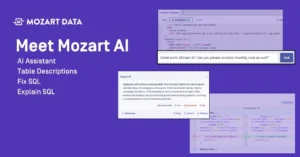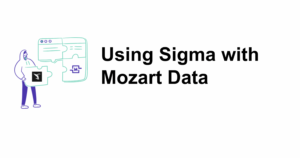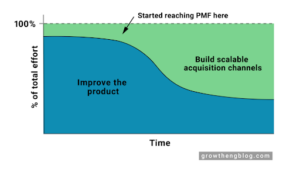Your business is collecting a lot of data, and it’s stored in platforms used by teams across departments. These platforms have native reporting and analysis tools that generate valuable insights for its users, whether in marketing, product, finance, etc. However, the utility of siloed data is limited, even for the team collecting it, because they lack insight into the bigger picture. To make data meaningful for the broader business, it must be combined with other relevant information to create a comprehensive, centralized data set.

This is where data extraction comes in. This process collects raw data from scattered sources so it can be cleaned, transformed, and loaded into a central warehouse for easy access and analysis — ultimately replacing spreadsheets and strung-together integrations with automatically updated dashboards.
To better understand why data extraction is important, we’ll review how the process works and look at data extraction examples that illustrate the benefits.
Data extraction unites business units
Your customers and prospects interact with different parts of your business. Each of these isolated touchpoints have valuable information at the individual level and in aggregate. By extracting and combining this data from sources across the company, you enable decision makers to gain a better understanding of their customers, monitor the health of the business, and make informed product decisions.
To better understand the benefits of data extraction, consider a single customer’s journey from acquisition through churn. Let’s take the example of a company with a subscription-based business model for their products or services. Each of these stages might be owned by a discrete business unit, but the data collected is valuable to stakeholders company-wide.
- Subscriber acquired through sales with a contact record stored in Salesforce
- Sent marketing email through Iterable for an upsell
- Retargeted with social media ads, managed through Facebook
- In-app purchase made with payment collected by Stripe
- App behavior is stored in a cloud database
- Calls customer service and the interaction is stored in Zendesk
- Six months after acquisition, the customer cancels their subscription
Analyzing any piece in isolation ignores the interconnected nature of these touchpoints. For example, marketing might have achieved statistically significant results from an email’s A/B test, but they remain unaware that the email caused confusion that led to a spike in customer service calls and ultimately resulted in cancellations.
Extraction enables you to unify multiple data sets into one single source of truth that all relevant teams can access to make data-driven decisions. For instance, the master data set can be mined for patterns that inform a more effective lead scoring model or identify indicators of customer churn. It’s also what makes the implementation of a multi-touch attribution model possible.
Getting the bigger picture
Raw data that’s stored in a platform, like a CMS or marketing automation software, will almost always contain flaws that can negatively impact an analysis. These occur as a result of manual inputs or processing errors and include duplicates, typos, inconsistent formatting, and missing values. Data extraction allows you to clean the information, removing the flaws, to prepare it for analysis or merge it with other cleaned data sets.
Sometimes, extracting data is the only way to include it in a larger analysis. Here’s an example.
Imagine a boxing gym with 10 locations around Maryland. New members use the gym’s tablet to complete a questionnaire before their first class. Each new response is recorded as a new row in a shared spreadsheet specific to that location. Every month, marketing downloads 10 individual spreadsheets locally so they can combine the data into one master spreadsheet. They create pivot tables to review specific questions, like how the new members heard of the gym, and adjust their advertising tactics based on their findings.
This data extraction example is based on a dated, manual process that allows room for error at each human touchpoint. This is where a modern data stack like Mozart Data can add immense value, automating the workflow after form submission and delivering clean data to marketing. It’s a simple three-step process:
- Extract data from its original source — whether a CSV file, SaaS solution, or advertising management platform — and load it into a managed data warehouse.
- Clean and transform the data.
- Sync the data to a business intelligence tool to automatically update dashboards in real time.
This not only allows marketing to conduct an analysis based on reliable information, but it also expands employee bandwidth by implementing efficient processes that eliminate time-consuming manual tasks.
Benefits of automated data extraction
We’ve illustrated why unified data supports informed decision making, but the benefits of data extraction extend even further thanks to software like Fivetran, which has tools that automate the data extraction process.
Increased efficiencies
Automation eliminates the manual tasks of extracting data from multiple sources, combining spreadsheets, keeping values up to date, and later resolving human-introduced errors. This frees up employees for higher-value work.
Improved accuracy
The speed and accuracy of a digital workflow will beat a manual process every time. Therefore, data integrity is strengthened by automation. This gives decision makers more confidence in the data and the resulting analysis.
Real-time decision making
Automation makes it possible to extract new, updated data whenever it’s available. Real-time data is essential for agile decision-making and capitalizing on new opportunities in the market.
Visibility
Breaking down the silos between data sets removes gatekeepers and makes key data accessible to stakeholders across the company.
Simplified sharing
With a data extraction tool integrated into your modern data stack, shared dashboards are updated automatically, and it’s quick and easy to share select information with internal teams or external partners.
Supporting growth
With real-time information collected at scale, leaders can quickly make informed decisions that drive the business forward.
Mozart Data simplifies the process of setting up a modern data stack with extract, transform, and load capabilities through native Fivetran and Snowflake integrations. To get started, connect your data sources to Mozart in minutes, and then the system will automate the process of extracting and centralizing all your data in a warehouse. To better understand how Mozart’s built-in data extraction capabilities can benefit your business, schedule a demo with us today.


